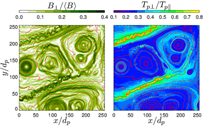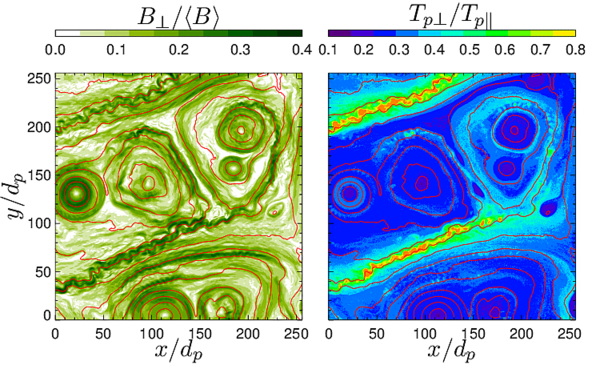Turbulence vs kinetic instabilities

Two dimensional expanding box hybrid simulations clearly demonstrate
that kinetic instabilities may coexist with strong plasma turbulence and bound the plasma parameter space.
The solar wind is characterized by large-amplitude plasma turbulence, a ubiquitous nonlinear phenomenon. Turbulence allows energy transfer from large to small scales, and leads, eventually, to plasma energization. Properties of plasma turbulence and its dynamics remain an open challenging problem in laboratory, space and astrophysical contexts. Beside the large-amplitude plasma turbulence, the solar wind plasma exhibits many apparent bounds which indicate that plasma properties in the weakly collisional solar wind are constrained by kinetic instabilities. However, theoretical linear and nonlinear properties of kinetic instabilities are usually investigated assuming a homogeneous plasma system which is not compatible with the presence of large-amplitude turbulent fluctuations.
Using 2-D hybrid simulations
Hellinger et al. (2015) investigated the relationship between plasma turbulence and kinetic instabilities a slowly expanding solar wind. The numerical model shows that the turbulent heating is not sufficient to overcome the expansion driven anisotropic cooling in agreement with in situ observations in the solar wind and that for a sufficiently large parallel proton temperature the oblique firehose becomes active and reduces the temperature anisotropy. This work clearly demonstrates that kinetic instabilities may coexist with strong plasma turbulence and bound the plasma parameter space.
 Figure 1
Figure 1: (left) Magnitude of the perpendicular fluctuating magnetic field
Bperp and (right) the proton temperature anisotropy
Ap in the simulation
x-
y plane (only a quarter of the simulation box is shown) at the end of the simulation. Red lines show selected magnetic field lines. The system is characterized by coexistence of vortices and fire hose driven oscillating wave packets which reduce the proton parallel temperature anisotropy.
References
Hellinger, P., L. Matteini, S. Landi, A. Verdini, L. Franci, and P. M. Travnicek (2015), Plasma turbulence and kinetic instabilities at ion scales in the expanding solar wind,
Astrophys. J. Lett.,
811, L32.